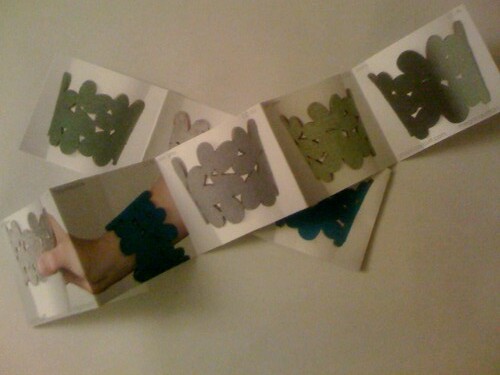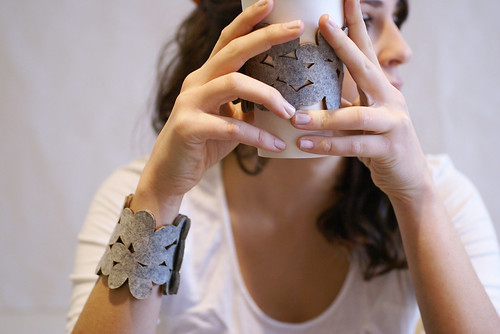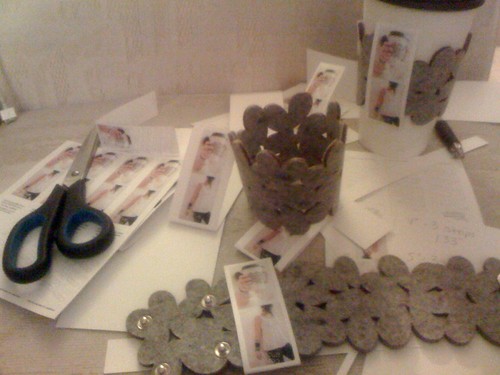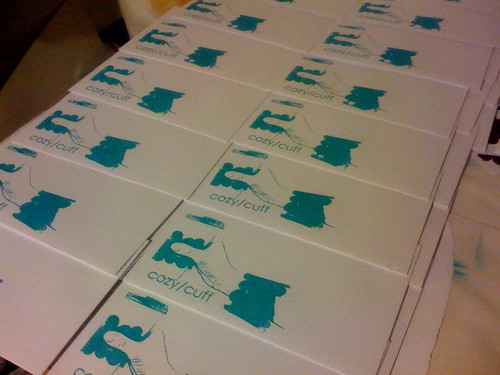I’ve been working on lots of new promotional materials to get ready for the gift fair – postcards, and catalogs, and the new website – but I keep getting stuck every time I try to write the copy.
At this point, I’m just a little too close to the product. So I need your help!
If you were writing about the cozy/cuff, what would you say? How would you describe it? What are its benefits? Can you describe its style and function in one short sentence? What aspects about it do you like best?
Leave your thoughts in the comments, and I’ll pick one winner to send your very own cozy/cuff!
Thanks in advance!
"packaging"
So I guess I wished everyone happy holidays a little early, because I still haven’t started my Christmas vacation yet.
I’ve been working on some new “packaging” for the cozy/cuffs. While they’ve been selling really well online, I’m having a little trouble with them in retail venues. Online, I can totally communicate all the product uses with a few good photos, but in person they are hard to understand.
Ok, that’s not entirely true – if you see one being worn or used on a coffee cup, they make perfect sense. Its just in a retail display, they are a little tricky. And with the gift fair right around the corner, I really need to resolve that.
So I’m trying to work on a tag that clearly displays the dual function of the cozy/cuff, without bogging it down with excess packaging. And since I took some new product shots that I’m totally loving, I’m working on incorporating those into the “packaging.”
envelopes
online catalog
Today is the first day of the Museum Store Association Expo, and other than the cozy/cuff catalog, I didn’t get a print catalog finished of all my work. I’m a little disappointed, but I just didn’t feel settled enough with my images to spend the money on something that felt as final as a print catalog. Instead, I completely redid my online catalog. Now, all my current work is available to view in one place. And its helping me move closer to the full redesign of my current website.
shopcozycuff.com is live
For the last week, I’ve been working hard on a new website – shopcozycuff.com! I decided since I’m focusing on really promoting the cozy/cuff, it deserved its own website. When I went to register the domain name, cozycuff.com was already taken. I debated about using cozy-cuff.com, but I’m not a fan of using the dash in a website. I think its easy to forget to put it in, and then someone looking for my cozy/cuff ends up at a different website.
But shopcozycuff.com is just the start – I’m hoping to do a major redesign of my main website, meganauman.com in the next few weeks.
Next up for the four week marketing plan, its time to compile that list of retailers and start sending out information!
and the winner is…
Well, it looks like I’ll be hand delivering the cozy/cuff because the randomly chosen winner of my contest is Lynette! Lynette, let me know what color you’d like, and I’ll bring it with me on Thursday.
Why am I hand delivering the cozy/cuff, you may ask. Well, on Thursday, I head to Phoenix and Tempe – first up a visiting artist gig at ASU, then the Museum Store Association Expo.
Thanks to everyone who suggested a retailer! So many of those are places I would have never discovered on my own. I’m still cranking away on my four weeks of marketing – this week I’ll be working on compiling a list of stores and press to send info to. Plus, I’m working on a major website re-design. (Not to mention prepping for my trip!)
what I’m reading
Normally I like to put the title of the book I’m reading in the title of the post, but The Entrepreneur’s Guide to Patents, Copyrights, Trademarks, Trade Secrets, & Licensing seemed a little wordy. Long title aside, this is an excellent book that really highlighted the differences between copyright, trademarks, and patents. If you run any kind of creative business, I highly recommend that you read this book. As I read, I was able to clearly apply the discussions to my own work.
Here’s a little summary, and how it applies to my work:
Trademarks
Trademarks cover the source of the product, not the product itself (even though we might call a product by its trademark name). One example is that Twinkie is the source of a snack cake (ie. Twinkie brand snack cake). Coca-Cola is the brand of soda, etc.
It is difficult to trademark a “weak” mark – meaning a trademark that is purely descriptive of a product. The “strongest” marks are those that have no relation to the products being sold. (Such as Apple computers.) Which means I would have a difficult time trademarking cozy/cuff – its really just a descriptive name. If I wanted to trademark cozy/cuff, I’d have to prove secondary meaning – basically, that I’ve used the name so much that it is now synonymous with only my brand. That takes time to establish, so for now, no trademarking of cozy/cuff.
Copyrights
This is the area where I though I understood the most, but it turns out I still have so much to learn. Did you know that you can’t copyright useful things? Copyrights are meant to protect expressive works. However, there is a blurry boundary between creative and useful objects and copyright can cover certain aspects of a useful object.
According to the book, “Copyright is best suited for art that appears on functional objects such as a design or ornamentation that is not part of the physical, functional structure of the object.” This really struck me, because one of the ideas I work with is that surface is structure, that the pattern designs become the objects themselves.
I’ve already filed for a copyright for the cozy/cuff, and ultimately, this should give me some level of protection if someone were to copy my idea directly. But if copyrights don’t cover it, then what’s left?
Design Patents
The other option is to file for a design patent. “Design patents are best suited for protecting the shape and appearance of useful objects such as perfume bottles bottles, furniture, cars, and appliances, which have designs that have commercial and economic value.” This does seem much more applicable to my work. However, while easier to apply for than a traditional patent, design patents are still difficult to obtain and expensive. Based on the costs on the PTO website, it would cost over $600 dollars to apply for a design patent, plus over $3,000 in maintenance fees over the next 12 years. And those are the reduced rates for small businesses! And you must apply for a design patent within one year of an object being sold or used.
Unfair Competition
After reading most of the book, it did seem like there were still a lot of opportunities to have others steal your ideas or designs. Fortunately, there is one more method of legal recourse – which is unfair competition. This affords some protection for someone who is copying aspects of your design in such a way that (while not covered under copyright, trademark, or patent) that seeks to confuse the public on the identity and source of the product. This should offer some means of protection over someone trying to co-opt your entire brand identity as their own. (At least I hope this is the case).
One last thing I learned from the book is no matter what form of intellectual property law you are covered under, you must constantly police for infringers of your work.
This is just a small snippet of the information covered in this book, and some of the ways I’ve applied it to my situation. This book is a worthwhile (and easy) read – its not too legal-jargon-y, and really helped me understand the differences between copyright, trademark, and patents.
mock-ups
I sort of fell behind on the four week marketing project in all the preparations for our San Francisco trip, but I’m quickly getting back on track. This morning I photographed all the new cozy/cuff colors and re-photographed the grey and black so that all the images were consistent.
After a lengthy photo-editing session, I started working on my mini-catalog. Its in the form of a little accordion fold-out booklet. I decided to keep the catalog simple and graphic, with the focus on the images. When I send them to retailers, I’ll include a cover letter and info sheet. I’ve still got a few minor changes to make, but I need to order them from the printer in the next day or two. What do you think?

Working on the mini-catalog also gave me an idea for the layout of the website. I did this quick little mock-up in Illustrator, but I’ve still got to build the whole website. So more to come on that later…
suggest a retailer for the cozy/cuff
Is there a retailer in your area that would be a good fit for the cozy/cuff? I’m looking for coffee shops, design stores, indie boutiques, or any other store that might carry the cozy/cuff.
If you’ve got a suggestion, please leave a comment with:
-the name of the store
-store address (at least city and state)
-web site (if they’ve got one)
-any other info about the store
If you don’t want to leave the info in the comments, you can always email me at meauman(at)yahoo(dot)com.
And in case you really need a reason to suggest a retailer, I’ll choose one lucky commenter (or emailer) on April 24 to receive a cozy/cuff of their very own!
what’s in a name?
cozy/cuff
A few comments on my last post prompted me to really think about the name cozy/cuff. After all, for $300, I better be damn sure.
Here are the reasons I like cozy/cuff:
-I’ve always been a big sucker for alliteration, I think it makes something fun and memorable.
-I’m a big fan of the backslash. I think it communicates that the object can actually be two objects – a cozy or a cuff. (Yes, I technically realize that its not really a cuff, in the traditional open cuff format, but like I said, I like alliteration.)
-The no caps thing is something I do with my business name, so I’d like to continue it with the cozy/cuff (as well the font I typically use – century gothic) to have some continuity.
So what does everyone think – go with cozy/cuff, tweak it a little bit, or come up with something new altogether?









